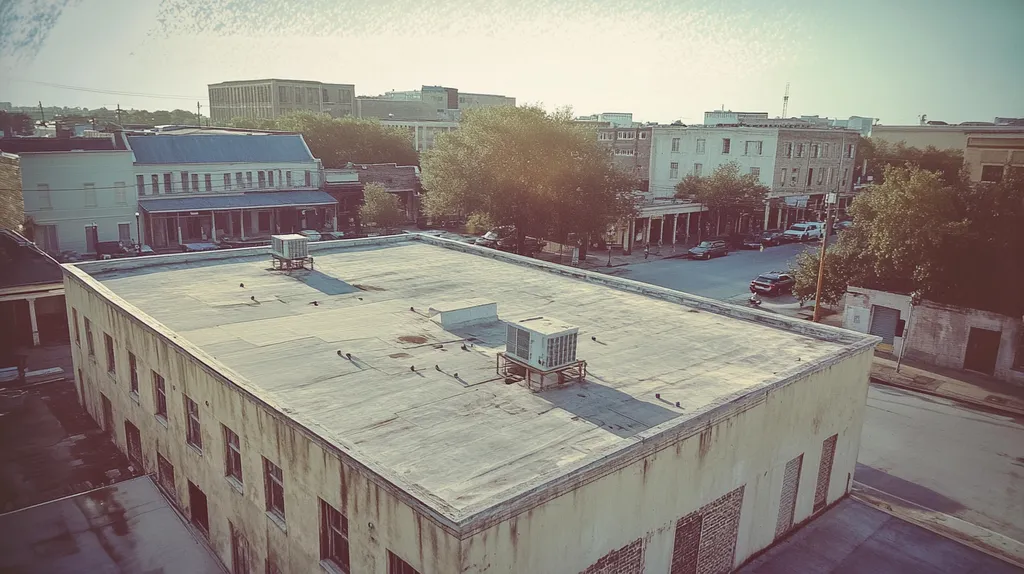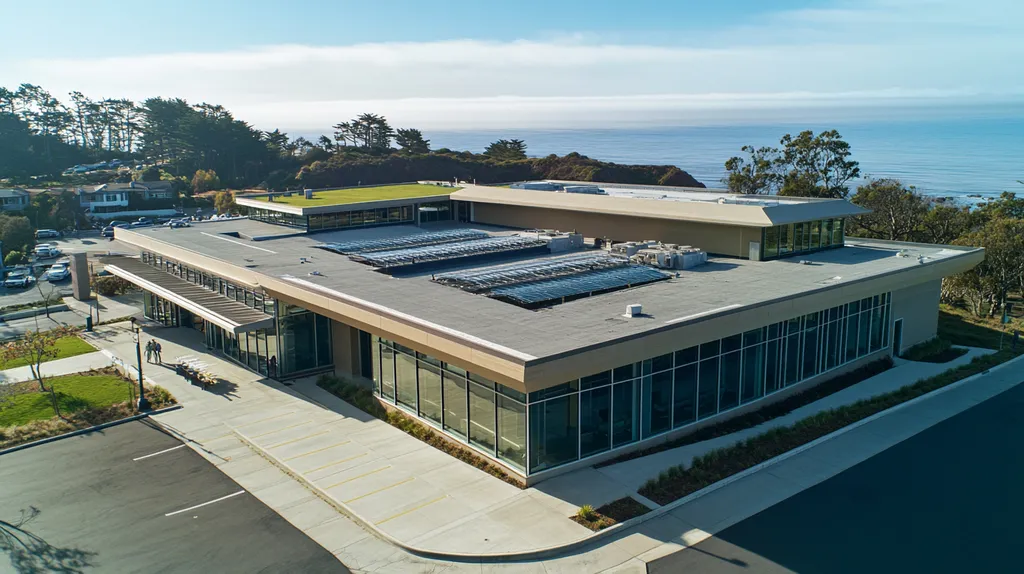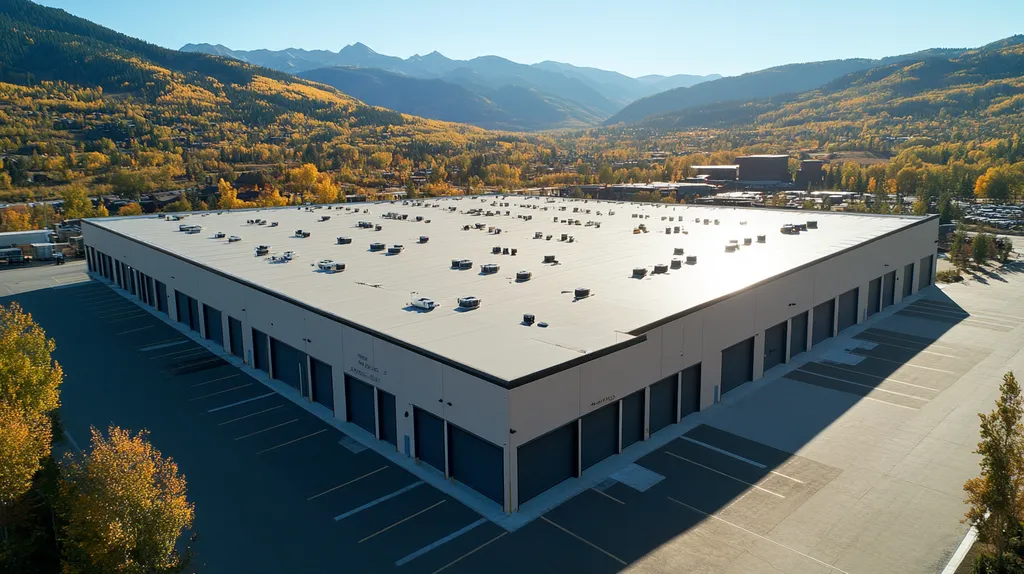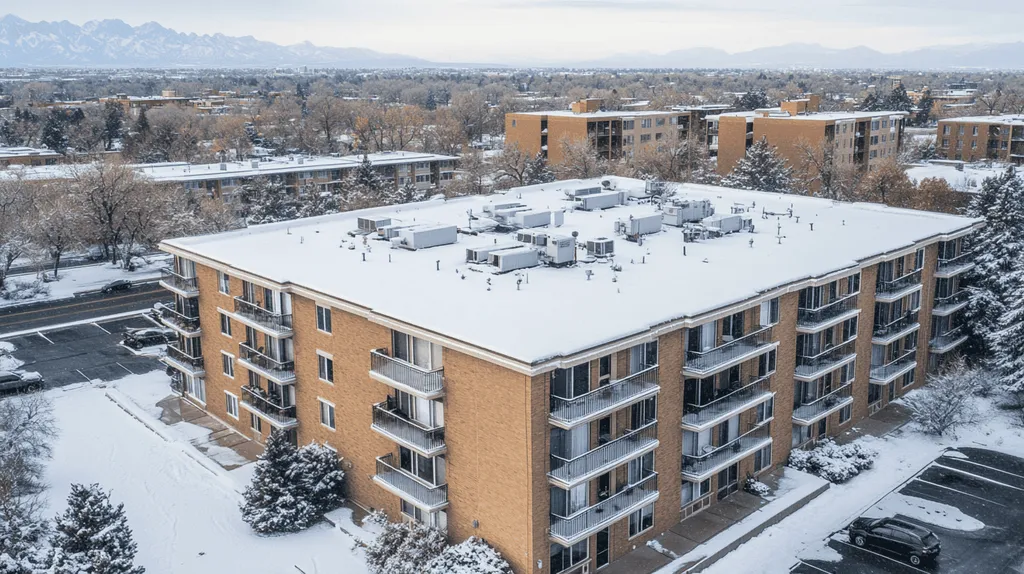In today’s industrial facilities, inadequate roof insulation thickness wastes over $5 billion annually in energy costs across North America. Despite this staggering figure, many property owners continue to rely on outdated assumptions about insulation requirements.
The consequences of improper insulation extend far beyond higher utility bills, potentially compromising structural integrity and indoor environmental quality.
This analysis examines prevalent industry myths about insulation thickness, revealing how evidence-based approaches to industrial roof insulation can reduce energy consumption by up to 30% while extending roof life expectancy.
SECTION 1: COMMON MISCONCEPTIONS
Many property owners and facility managers harbor misconceptions about the role of insulation thickness in industrial roofing. These misunderstandings can lead to wasted energy, inflated costs, and unnecessary maintenance. For instance, inadequate insulation can cause energy costs to soar by over 30%. Recognizing the subtleties of insulation is essential for making knowledgeable choices that improve energy efficiency.
One-Size-Fits-All Insulation
A widespread myth is that a universal insulation type can meet the needs of all industrial buildings. In truth, each facility has specific energy requirements based on its size, function, and structure. Ignoring these distinct needs can compromise insulation performance.
For example, a warehouse in a high-temperature setting will require a different thickness of insulation compared to a refrigeration facility. Overlooking such differences can lead to discomfort and excessive energy bills, as the HVAC system works overtime to maintain optimal temperatures.
Additionally, pre-packaged insulation solutions fail to consider roof designs that may include slopes or various penetrations. Adapting insulation types and thicknesses to fit the building’s layout can lead to meaningful energy savings.
To maximize energy efficiency, it’s crucial for property owners to consult roofing professionals who can assess the specific insulation requirements of their facilities. A customized approach can significantly reduce operational costs and enhance energy performance.
Ignoring Climate Zones
Another common misconception is neglecting how climate zones influence insulation needs. Each region has unique climate characteristics that dictate the level of insulation required for optimal energy efficiency. Failing to consider these factors leads to inadequate insulation strategies.
For instance, buildings in colder climates necessitate thicker insulation than those in milder weather. Enhanced insulation in colder regions minimizes heat loss during winter, ultimately lowering heating expenses. Conversely, facilities in warmer areas need insulation that aids in keeping indoor temperatures cool.
Disregarding local climate conditions can create significant energy inefficiencies. Facilities that fail to adjust insulation thickness based on geographic context may inadvertently increase their energy consumption by up to 25% over time.
To ensure insulation choices align with local climate specifics, property owners should seek expert advice tailored to their geographic location. This proactive approach supports energy conservation and boosts overall sustainability.
Overlooking Material Differences
The final misconception pertains to the significance of insulation material variations. Different insulation types—such as fiberglass, foam, or cellulose—possess distinct thermal properties. Misunderstanding these differences can lead to inadequate energy performance.
For example, closed-cell foam insulation provides superior R-values in thinner applications compared to traditional fiberglass, making it ideal for facilities with limited space. Choosing the right insulation material is vital for achieving optimal thermal efficiency and energy savings.
Moreover, insulation materials do not perform uniformly across different humidity and temperature conditions. The appropriate insulation must align with the facility’s specific needs while considering environmental factors.
Property owners are encouraged to collaborate with knowledgeable professionals who understand these material differences. A thoughtful material selection process can greatly enhance energy efficiency and reduce long-term operating costs.
SECTION 2: PRACTICAL IMPLICATIONS
The choice of insulation thickness goes beyond mere technicality; it significantly impacts energy costs and the overall performance of an industrial building. When insulation is inadequate, the financial consequences can be steep, with energy inefficiencies contributing to heating and cooling expenses that can soar by as much as 30%. Understanding these implications is essential for property owners and facility managers who are keen on optimizing energy efficiency while reducing operational costs.
Impact on HVAC Efficiency
The thickness of insulation is critical for the efficient operation of HVAC systems. When insulation falls short, HVAC units are forced to work harder to achieve and maintain comfortable indoor temperatures. This increased effort leads not only to higher energy bills but also to potential wear and tear on the equipment, reducing its overall lifespan.
For example, consider a facility insulated to R-19 versus one with R-30 insulation. The former might face augmented energy expenditures since the HVAC system runs longer to make up for lost thermal energy. Each additional insulation R-value contributes directly to better thermal resistance, translating to more efficient energy consumption.
Additionally, roofs that are poorly insulated can create uneven temperature distributions within the building. This inconsistency pushes HVAC units to operate more aggressively, which in turn elevates maintenance demands and overall costs. Choosing the right insulation thickness is not just beneficial; it’s vital for enhancing HVAC system efficiency.
In the end, selecting the appropriate insulation thickness can profoundly boost HVAC efficiency, leading to cost savings that accumulate over time. Property managers should prioritize insulation upgrades as part of their comprehensive climate control strategy.
Effects on Indoor Temperature Stability
The thickness of insulation greatly affects the stability of indoor temperatures, a crucial factor for many industrial operations. When insulation is insufficient, temperature fluctuations can disrupt workflows or damage sensitive products. For example, manufacturing facilities might see a rise in defects stemming from unstable temperature control, compromising product quality.
Studies indicate that buildings equipped with effective insulation maintain a more stable indoor climate, which in turn enhances worker comfort and productivity. For industries requiring precision, stable temperatures are essential for peace of mind.
Moreover, effective insulation helps reduce the likelihood of condensation buildup, which can lead to moisture problems and mold growth. Such issues not only endanger the structure but also pose health risks to employees. Maintaining consistent temperatures through appropriate insulation thickness is, therefore, vital for ensuring a safe and productive working environment.
Ultimately, the right insulation thickness directly correlates with temperature stability and operational reliability, making insulation choices critical for business continuity.
Consequences for Building Integrity
Choosing the correct insulation thickness can have significant implications for the overall integrity of a building. Insufficient insulation may cause thermal bridging, allowing heat to escape through structural components. This not only elevates energy costs but may also lead to structural damage over time.
Take, for instance, commercial buildings that experience ice dam issues—a scenario that often leads to roof failure and expensive repairs. Heat escaping from poorly insulated areas can result in ice accumulation, which can inevitably cause leaks and extensive damage. Such examples highlight the necessity of diligent insulation planning.
Additionally, improper insulation can lead to condensation problems, resulting in water damage and mold. Facilities grappling with moisture issues face not only hefty repair costs but also potential regulatory challenges due to safety violations.
A well-insulated roof contributes significantly to the long-term durability and resilience of all building structures. Owners and facility managers must recognize that insulation thickness is a key factor that can influence the lifespan and value of their assets.
SECTION 3: COST OF MISINFORMATION
The consequences of misconceptions about insulation thickness in industrial roofing can be financially devastating. Property owners may not realize that inaccurate beliefs can inflate energy costs significantly, affecting a company’s profitability. For instance, a 20,000 square-foot facility could lose thousands of dollars each year due to inadequate insulation. Therefore, grasping the true impact of insulation metrics is crucial for making informed and cost-effective decisions.
Increased Energy Consumption
Many facility managers underestimate the profound effect of insulation thickness on energy efficiency. When insulation is insufficient, heat escapes during the winter and enters in the summer. This back-and-forth shift forces HVAC systems to work much harder, leading to increased energy consumption.
For example, facilities with inadequate insulation can see energy bills rise by 30% or more. This spike not only strains operating budgets but also eats into profit margins, underscoring the importance of conducting accurate insulation assessments.
Moreover, this higher energy consumption contributes to a larger carbon footprint. Companies focused on sustainability face additional challenges when their roofing systems fall short in energy efficiency. This lag can harm their reputation and compromise compliance with environmental regulations.
Investing in appropriate insulation thickness can lead to significant reductions in energy bills. Hence, facilities should conduct regular evaluations to ensure they are not falling prey to the pitfalls of misinformation.
Higher Maintenance and Repair Costs
Misunderstanding insulation requirements can lead to escalating maintenance expenses. Poor insulation often results in condensation problems, fostering mold and structural damage. These issues frequently go unnoticed until they culminate in serious structural impairment.
Facilities that neglect proper insulation may find their maintenance costs climbing by as much as 25%. This increase stems from frequent repair needs and mold remediation efforts, placing a heavy burden on facility management teams.
Additionally, the necessity for ongoing repairs can lead to extended downtimes. Such disruptions can undermine operations and impact service delivery, leading to potential customer loss and corresponding revenue declines.
By taking a proactive stance on insulation, businesses can minimize maintenance costs and extend their roof’s lifespan. Recognizing the integral role of insulation thickness empowers facility managers to make decisions that benefit both financial and operational outcomes.
Reduced Property Value
The effects of misinformation also extend to property values. Buildings with inadequate insulation may suffer from decreased market appeal. Buyers and tenants may view poor insulation as a warning sign, raising doubts about the facility’s energy efficiency and operational costs.
Research indicates that properties optimized for energy efficiency can command higher prices in the real estate market. In contrast, buildings burdened with high operating costs may see their values plummet by 10-15%. Thus, misunderstanding insulation thickness can result in significant long-term financial drawbacks.
Furthermore, failing inspections due to insulation deficiencies can complicate the selling process. Owners might need to invest further in upgrades to address these issues, ultimately detracting from potential profits during a sale.
For property owners, ensuring optimal insulation is crucial for maintaining a robust asset position in the market. Decisions informed by accurate information yield not only immediate cost benefits but also long-term value enhancements.
SECTION 4: REALITY CHECK
Understanding insulation thickness is crucial for optimizing energy efficiency in industrial roofing. Rising energy costs make it essential for property owners to view insulation as a necessary investment rather than just a building material. A slight increase in insulation thickness can lead to substantial savings on heating and cooling bills. This section will clarify R-values, address climate-specific insulation needs, and stress the importance of proper installation to achieve peak performance.
Understanding R-Values and Thermal Conductivity
The R-value measures how well insulation resists heat flow. Higher R-values translate to better insulating effectiveness. For industrial buildings, selecting insulation with the right R-value can significantly cut down energy losses. Different materials display varying R-values; for example, fiberglass often ranges from 3.1 to 4.3 per inch, while polyurethane foam can reach as high as 6.5 per inch.
However, simply focusing on R-value doesn’t tell the whole story. Installation methods and the integrity of the building envelope also affect energy efficiency. Leaks or gaps can significantly diminish the performance of even high-R-value insulation, resulting in escalating operational costs.
By investing in appropriate insulation materials and installation practices, facilities can achieve consistent indoor temperatures. This not only enhances comfort but also reduces energy consumption.
Climate-Specific Insulation Requirements
Every climate brings unique demands that shape effective insulation choices for industrial roofs. For example, areas experiencing extreme heat may need reflective roofing coupled with thicker insulation to mitigate thermal gain. Conversely, colder regions require thicker, high-R-value insulation to dramatically reduce heat loss.
For instance, an industrial building in the Northeast might need R-values of 30 or higher for effective energy efficiency, while one in the Southwest may benefit from a cool roof to minimize heat absorption. Acknowledging these climate-specific needs is essential for developing effective, tailored insulation strategies.
Additionally, the type of insulation materials can be influenced by climate conditions. Some products, like cementitious insulation, may perform better in humid environments, whereas polyisocyanurate might be more suitable for drier climates.
Ultimately, property owners should prioritize understanding local climate patterns and seek expert advice to inform their insulation strategies. Selecting the right materials and thickness tailored to these factors can yield substantial energy savings.
Importance of Proper Installation
No matter how high-quality the insulation material, proper installation is critical for unlocking its full potential. Gaps, poor sealing, and installation errors can undermine energy efficiency, with estimates indicating that 20% to 30% of expected insulation effectiveness may be lost due to improper practices.
If insulation is not tightly fitted, the phenomenon of thermal bridging may occur, where heat passes through areas with lower insulating properties. This renders high-R-value materials less effective.
The chosen installation method is also vital; whether using tapes, adhesives, or mechanical fasteners, they must align with the specific insulation material. Misalignment can lead to moisture accumulation and subsequent damage to the roofing system.
Regular inspections and ongoing maintenance after installation are essential to ensure sustained performance. Property managers should focus on both the type of insulation and the quality of its installation to protect their investment and promote energy efficiency.
SECTION 5: EVIDENCE-BASED ALTERNATIVES
As energy costs climb, understanding insulation options takes on heightened importance for industrial buildings. The right insulation material can dramatically enhance energy efficiency and lower operating costs. Research indicates that selecting appropriate insulation can lead to energy savings of up to 30%. This section explores the essentials of choosing insulation materials, determining optimal thickness, and the benefits of professional installation, equipping decision-makers with the knowledge to make informed choices.
Selecting the Right Insulation Material
Selecting the correct insulation material is crucial for maximizing energy efficiency. Materials such as fiberglass, foam board, and closed-cell spray foam each come with distinct advantages. For instance, closed-cell spray foam delivers a high R-value per inch, proving effective even in thin applications. Choosing the wrong type can lead to higher energy bills and discomfort due to inadequate thermal performance.
When selecting insulation, consider the specific needs of the building, including its climate, intended use, and roof configuration. Familiarity with local building codes is essential since they often set minimum insulation standards. Additionally, select materials that facilitate moisture management to guard against mold and structural damage.
Property owners should engage insulation specialists to explore their options thoroughly. Such collaboration provides invaluable insight into ensuring long-term performance and sustainability. Investing in research today can translate into significant savings on energy expenses down the road.
Evaluating the reputation of manufacturers and the anticipated lifespan of insulation materials is equally important. While some materials may appear cheaper initially, their shorter lifespan can result in more frequent replacements and ultimately higher costs. Thoughtful selection of insulation lays the foundation for a more energy-efficient building.
Calculating Optimal Insulation Thickness
Calculating the optimal thickness of insulation is key to maximizing energy savings. Simply adding more insulation doesn’t guarantee better performance; a balance must be struck between thickness and cost-effectiveness.
Industry professionals recommend assessing insulation requirements based on local climate conditions and specific building characteristics. For example, facilities in colder climates will typically need thicker insulation than those in milder zones. Utilizing energy modeling software can help achieve precise calculations.
It’s important to note that excessive insulation can inflate upfront costs unnecessarily. Focusing on the R-value—an indicator of insulation performance related to thickness—is vital. The goal should be to attain a sought-after R-value that meets energy efficiency targets without excessive spending.
Consulting with energy consultants can further streamline the calculation process. These experts can offer tailored strategies specific to the building’s needs, driving decisions that improve energy efficiency while adhering to budget constraints.
Benefits of Professional Installation
Professional installation is essential for ensuring optimal insulation performance. Even the highest-quality materials can fail to perform if installed incorrectly. Mistakes during installation can create gaps and thermal bridges, leading to energy loss and diminishing effectiveness.
By hiring experienced contractors, building owners can ensure that insulation is properly fitted and compliant with local building regulations. Skilled installers are adept at navigating the intricacies of various materials, including ensuring adequate ventilation to prevent moisture accumulation.
Moreover, professional installation often enhances warranty coverage. Many manufacturers offer warranties that only apply when products are installed by certified professionals, adding an extra layer of protection for your investment.
In addition, professional installation can save valuable time. Experienced teams work efficiently to complete projects quickly, minimizing disruption to ongoing operations—a key consideration for facility managers looking to enhance their roofing systems.
SECTION 6: TEST AND VERIFY
To ensure that insulation thickness genuinely enhances energy efficiency, rigorous testing and verification are paramount. Many industrial buildings operate on outdated assumptions about insulation performance, which can result in significant energy waste and rising operating costs. The U.S. Department of Energy estimates that over 30% of a building’s energy use stems from inadequate insulation. Thus, a proactive stance on testing insulation can lead to notable financial and environmental rewards.
Industry Standards and Guidelines
Following established industry standards is essential for confirming insulation effectiveness. The American Society of Heating, Refrigerating and Air-Conditioning Engineers (ASHRAE) provides guidelines that specify minimum insulation thickness requirements for different climates. Compliance with these guidelines not only meets energy codes but also enhances overall building performance and reduces the risk of fines.
Building codes often specify required R-values that insulation must meet, ensuring a baseline of energy efficiency across various structures. Property owners need to understand these requirements to avoid costly missteps during construction or renovations.
Moreover, standards like the International Energy Conservation Code (IECC) include detailed recommendations for assessing insulation quality. By evaluating insulation against these benchmarks, facility managers can confirm their roofs are functioning correctly—ultimately improving energy efficiency.
Failure to adhere to these standards can lead to increased energy consumption and higher maintenance costs, as poorly insulated roofs may experience premature failures that disrupt operations.
Conducting Energy Efficiency Audits
Implementing regular energy efficiency audits is vital for pinpointing any insulation performance gaps. These evaluations analyze energy consumption patterns to identify areas where insulation may be lacking. Techniques such as infrared thermography can uncover deficiencies that are not visible to the naked eye, enabling targeted improvements.
Energy audits are crucial, especially for older facilities, which may have insufficient insulation due to changes in energy codes over time. This knowledge informs decisions about necessary upgrades or retrofits to enhance efficiency.
These audits should be ongoing rather than a one-time event. Regular assessments keep facility managers informed about evolving energy costs and regulations, helping ensure insulation remains effective over the long term.
Partnering with certified energy auditors provides tailored insights and recommendations unique to each facility. This collaboration helps property owners ensure compliance while maximizing energy savings.
Monitoring and Adjusting Insulation Performance
Once insulation has been installed and verified, continuous monitoring is critical. Utilizing thermostats, building management systems, and energy consumption meters allows property owners to track insulation performance over time. This data helps determine if insulation continues to meet energy efficiency goals.
Adjustments may become necessary as environmental conditions change or building usage evolves. For example, increased occupancy in a facility might require additional insulation to sustain energy efficiency. Regular monitoring helps catch drops in performance before they become costly energy losses.
Promptly addressing any damage to insulation, such as moisture intrusion or punctured membranes, is essential. Small issues can lead to more significant problems, reducing effectiveness and increasing expenditures. Taking immediate corrective action is crucial for long-term performance.
Furthermore, proactively managing insulation systems aligns with sustainability objectives. By committing to ongoing monitoring and adjustments, property owners can ensure their facilities not only operate efficiently but also support environmental responsibility.
The Bottom Line
With industrial facilities losing over $5 billion annually to inadequate roof insulation, the cost of inaction continues to rise dramatically each year.
The evidence clearly demonstrates that proper insulation thickness, when selected based on climate zones and building requirements, can reduce energy costs by up to 30% while extending roof life expectancy.
Moving beyond outdated industry myths requires embracing evidence-based approaches to insulation selection, professional installation, and ongoing performance monitoring.
For facility owners and managers, the path forward demands immediate action: conducting thorough energy audits, consulting qualified professionals, and implementing climate-specific insulation solutions.
The stakes are clear – continued reliance on inadequate insulation practices threatens not only operational budgets but also building integrity and environmental sustainability.
FREQUENTLY ASKED QUESTIONS
Q. What are common misconceptions about industrial roof insulation thickness?
A. Many property owners mistakenly believe that one type of insulation fits all industrial roofs. Each building has unique requirements based on size, purpose, and climate. Ignoring these specifics can lead to inefficient insulation and inflated energy bills.
Q. How does insulation thickness affect HVAC efficiency in commercial roofs?
A. The thickness of insulation is vital for HVAC performance. Insufficient insulation forces HVAC systems to work harder, leading to increased energy costs and equipment wear. Selecting the appropriate thickness enhances thermal resistance and lowers operational expenses.
Q. What are the financial consequences of misinformation about insulation thickness?
A. Misunderstanding insulation thickness can substantially inflate energy costs, leading to thousands lost annually. Inadequate insulation can increase energy consumption and reduce property value, making it crucial for property owners to be informed and proactive.
Q. Why are R-values important for industrial roof insulation?
A. R-values explain insulation’s resistance to heat flow, with higher values indicating better performance. Properly understanding R-values ensures that buildings maintain consistent temperatures and energy efficiency, crucial for reducing operational costs and enhancing comfort.
Q. How can facility managers calculate the right insulation thickness?
A. To calculate insulation thickness, consider local climate conditions and the building’s specific needs. Industry professionals recommend using energy modeling to determine the optimal R-value, balancing thickness with cost-effectiveness for efficient energy use.
Q. What benefits does professional installation of insulation offer?
A. Professional installation ensures optimal insulation performance by preventing gaps and thermal bridging. Experienced contractors adhere to local codes and offer warranties, ultimately resulting in energy savings, enhanced building durability, and minimal disruption during installation.
Q. How can ongoing monitoring improve insulation effectiveness in industrial buildings?
A. Continuous monitoring of insulation performance helps identify deficiencies and adjust as needed. Tracking energy consumption patterns and conducting regular audits ensure insulation remains effective over time, reducing energy waste and promoting sustainable building practices.











